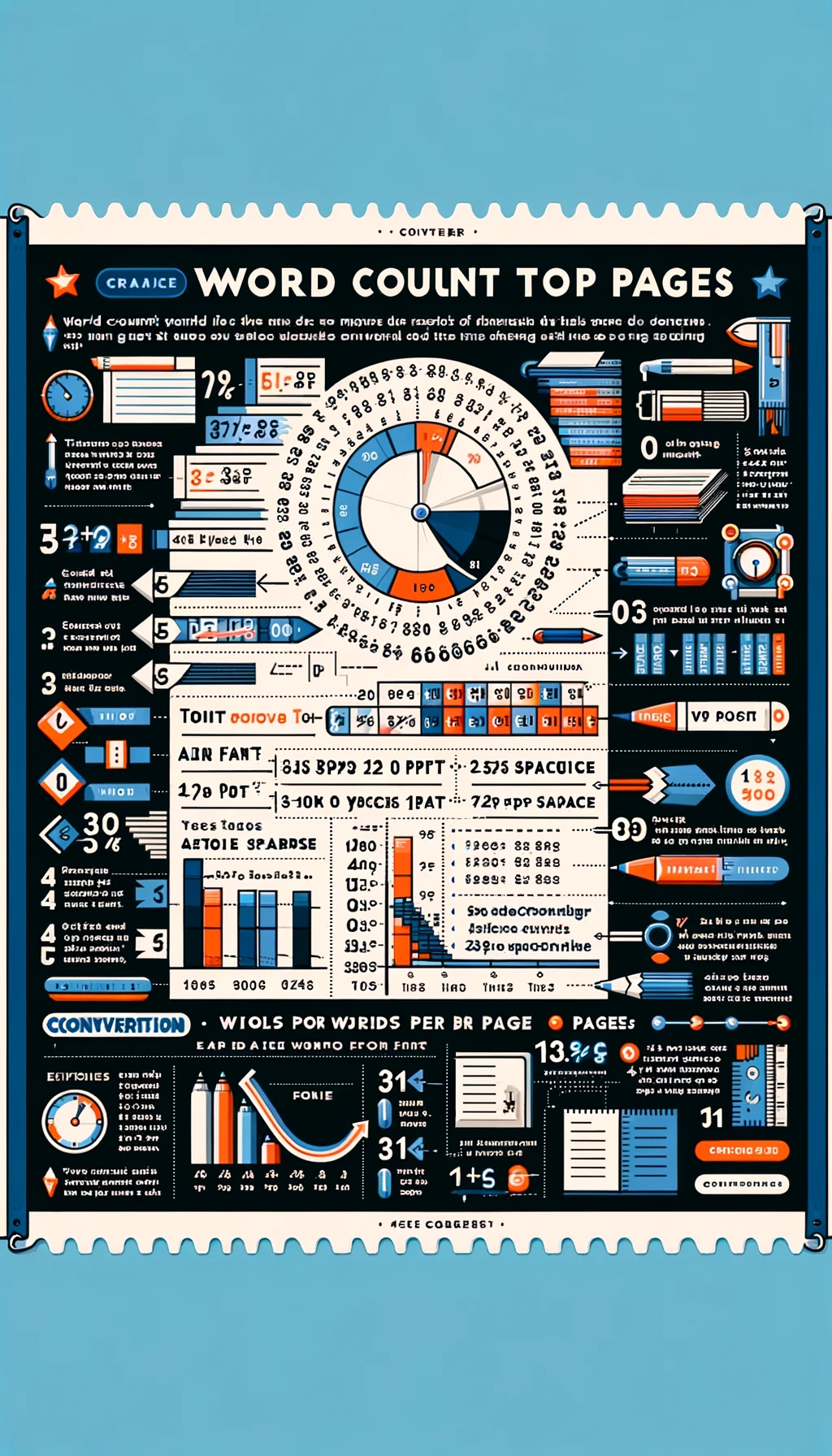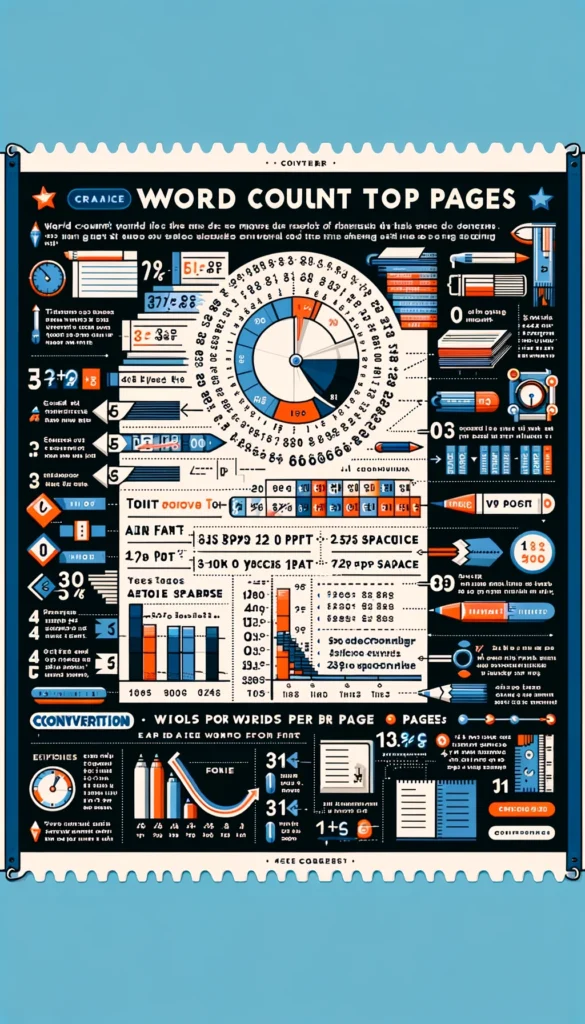Physical Address
304 North Cardinal St.
Dorchester Center, MA 02124


When embarking on any writing project, one of the first considerations often revolves around word count. Whether crafting a short story, drafting an article, or compiling research, understanding the significance of word count is crucial. It not only influences the structure and depth of your writing but also aligns your work with the expectations of your audience and publishers. Let’s delve into why word count matters, explore common writing formats and their typical lengths, and uncover the relationship between word count and page length.
Word count serves as a guiding principle in writing, helping to ensure that content is concise, relevant, and engaging. It acts as a boundary that encourages writers to refine their thoughts and convey messages effectively within a specified limit. In academic and professional settings, adhering to word count requirements is often mandatory, reflecting the writer’s ability to follow guidelines and respect constraints.
Moreover, word count can significantly impact the reader’s experience. A piece that’s too short may lack depth or fail to fully engage the reader, while an overly lengthy piece might become tedious and lose the audience’s interest. Balancing word count is key to maintaining engagement and delivering value.
Different writing formats come with varying expectations for length:
Understanding the norm for each format can help writers plan their work more effectively, ensuring that their projects are appropriately scoped for their intended format.
The conversion from word count to page length isn’t always straightforward, as it’s influenced by factors such as font size, typeface, spacing, and margins. Generally, a double-spaced page in Times New Roman font size 12 contains approximately 250-300 words. However, this can vary, so understanding the specifics of your formatting is essential for accurate estimation.
Several key factors affect how word count translates to page length:
This guide provides a foundational understanding of how word count influences various aspects of writing, from structuring your work to aligning with publishing standards. Use these insights to plan your writing projects, ensuring that your work not only meets the required word count but also delivers content in a manner that’s engaging and appropriate for your chosen format.
Remember, while word count is an important guideline, the quality of your writing should always take precedence. It’s the clarity, relevance, and impact of your words that ultimately resonate with readers.
When it comes to determining the number of words per page in a document, several key factors play crucial roles. Understanding these can help in planning and formatting written work, ensuring that content meets specific requirements, whether for academic papers, book publishing, or online content creation. Let’s dive into the primary elements that influence page coverage: font type and size, spacing, margins, paragraph structure and indentation, and the inclusion of non-text elements.
The choice of font type and size is the first and often most significant factor impacting words per page. Different fonts carry unique styles and spacing, which can either increase or decrease the amount of space that text occupies. For instance, serif fonts like Times New Roman are a staple in academic writing, often used at a 12-point size. This traditional choice provides a balance between readability and efficient use of space.
On the other hand, sans-serif fonts such as Arial or Calibri might seem more modern and are preferred for online content. However, they may occupy more space than their serif counterparts. A change in font size can dramatically alter page coverage. While a 12-point font is standard, opting for a smaller or larger size can respectively pack more or fewer words into the same page area.
Spacing between lines is another critical factor. Single spacing is the most compact, fitting the maximum number of words on a page. It’s common in scenarios where space is at a premium. However, for readability and editing purposes, many academic and professional settings require 1.5 or double spacing. Double spacing, in particular, significantly reduces the number of words per page but makes comments and corrections easier to insert and read.
The standard margin setting for documents is typically one inch on all sides, providing a clean and uniform look while maximizing the text area. However, variations in margin sizes can affect the word count per page. Expanding margins reduces the available space for text, thus decreasing the word count. Conversely, narrower margins can increase it, though they might compromise the document’s readability and overall appearance.
How paragraphs are structured and indented can also influence the number of words on a page. The traditional indentation of the first line in a paragraph helps signal a new thought or section without needing extra line breaks, saving space. Block paragraphs, separated by a blank line and with no indentation, might enhance readability in online content but can result in fewer words per page due to the added spaces.
Finally, incorporating non-text elements such as images, graphs, tables, or charts can drastically reduce the word count on a page. These elements are essential for breaking up text, providing visual interest, or illustrating data. However, their inclusion requires thoughtful planning to balance the informational or aesthetic benefits they offer with the space they occupy, which could otherwise be used for additional text.
Estimating the number of pages for academic writing projects is more than just a matter of curiosity. It’s a planning necessity. Whether you’re drafting a brief essay or embarking on a lengthy dissertation, understanding how various elements like format, citations, and footnotes impact page count is essential. Let’s explore these aspects across different academic writings, including research papers, theses, dissertations, essays, reports, and the role of citations and bibliographies.
Research papers are a cornerstone of academic writing, often adhering to specific formatting guidelines like MLA (Modern Language Association) or APA (American Psychological Association) styles. These guidelines not only dictate the style of writing but also affect page estimates through font type, size, margins, and spacing requirements.
Differences in title pages, headings, and section requirements between MLA, APA, and other formats (like Chicago or IEEE) can slightly alter the number of words fitting on a page, affecting the overall page count of a research paper.
Theses and dissertations represent the pinnacle of academic writing, encompassing extensive research and analysis. These documents are significantly lengthier, often requiring precise formatting that varies by institution. While the formatting might align closely with APA or MLA styles, the inclusion of numerous chapters, extensive methodologies, literature reviews, and findings sections means these documents can span hundreds of pages. Page estimation for these works heavily relies on the detailed structure and content required by the academic institution.
Essays and reports are more concise forms of academic writing, yet their page counts are influenced by similar formatting rules. Typically, these documents will follow MLA or APA guidelines but on a smaller scale. Essays often range from 5 to 7 pages, requiring clear, concise arguments, whereas reports might vary more significantly in length depending on the project scope. The clarity of writing and adherence to formatting rules can help in accurately estimating the necessary page count.
Citations and bibliographies are critical components of academic writing, providing sources and supporting research. The style of citation (MLA, APA, Chicago, etc.) can impact page count due to differing formats for in-text citations, footnotes, and bibliographies. For instance, APA’s author-date in-text citation style might use less space than MLA’s author-page format. Bibliographies or reference lists are usually single-spaced with a double space between entries, affecting the overall page count, especially in research-intensive papers.
Footnotes and endnotes offer additional information or citations without cluttering the main text. The choice between them and their formatting can influence page count. Footnotes appear at the bottom of the page where the note is referenced, potentially increasing the page count due to space taken. Endnotes, collected at the document’s end, might not affect the main text’s page count but will add pages at the document’s conclusion.
Estimating the number of pages for academic writing involves a nuanced understanding of formatting guidelines, the nature of the assignment, and the requirements for citations and ancillary information. By considering these factors, students and researchers can better plan and execute their writing projects, ensuring they meet the rigorous standards of academic excellence. Whether drafting a short essay or a comprehensive dissertation, the key to accurate page estimation lies in the details of formatting, organization, and content.
Professional writing spans a broad spectrum of formats, each serving a distinct purpose within the business, technical, and marketing realms. From succinct emails to comprehensive business reports, understanding how to estimate page lengths effectively is crucial for clear, impactful communication. This skill aids in planning, ensures clarity, and maintains the reader’s engagement. Let’s delve into the specifics of page estimates across various professional writing formats.
Business reports and proposals are fundamental to corporate communication, often guiding decision-making processes. These documents can vary significantly in length:
Technical documentation, including manuals, guides, and specifications, provides users with the information needed to understand or use a product or service. These documents are highly detailed, often extending to hundreds of pages for complex products. Effective technical manuals are structured for easy navigation, with clear headings, a detailed table of contents, and an index. Using concise language and including diagrams can make complex information more accessible, potentially reducing the need for extensive explanations.
Marketing materials like brochures and flyers are designed to capture attention and convey key information quickly. These materials are usually brief, ranging from a single page for a flyer to a few pages for a brochure. The focus is on high-impact visuals and engaging, concise text that communicates the core message or value proposition at a glance. The challenge lies in balancing creativity with information density to create compelling yet informative materials.
Grant and project proposals are critical in securing funding for various initiatives. These documents must strike a balance between providing enough detail to convince funders of the project’s viability and keeping the proposal concise to maintain interest. Typically, proposals range from 5 to 25 pages, depending on the grant’s requirements or the project’s scope. Clarity, well-defined objectives, and a compelling narrative are key to creating an effective proposal.
Emails and memos are staples of everyday professional communication, emphasizing efficiency and clarity. These documents are typically brief, often no more than a page. The goal is to convey the message or information as succinctly as possible while ensuring the communication is clear and actionable. Structuring these documents with a clear subject line or heading, a concise body, and a call to action can enhance their effectiveness.
In professional writing, estimating the appropriate page length is an art that balances the need to provide comprehensive information with the necessity of maintaining the reader’s engagement. Whether drafting a detailed technical manual or a concise email, the key is to focus on the document’s purpose, tailor the content to the audience’s needs, and structure the information for easy comprehension. By mastering these elements, professionals can enhance their communication effectiveness, ensuring their messages are not only received but also acted upon.
Creative writing encompasses a vast array of narratives, each with unique conventions for length, structure, and format. From the expansive development of novels to the concise impact of poetry, understanding how word counts translate into pages is crucial for writers across all genres. This knowledge not only helps in planning and structuring works but also in meeting the expectations of publishers and audiences. Let’s explore how these standards apply across different forms of creative writing.
The length of novels and novellas varies widely, often influenced by genre conventions:
Screenplays and scripts for film, television, and radio adhere to precise formatting guidelines, making page estimates more straightforward. A common rule is one page per minute of screen time. Therefore, a standard feature-length screenplay might range from 90 to 120 pages. The format includes specific margins, font (Courier 12-point), and spacing to ensure this consistency.
Poetry is unique in that traditional word counts and page estimates often do not apply. Poems can range from a single line to multiple pages, with the layout and white space playing critical roles in the reading experience. Poetry volumes vary significantly in length, typically published based on thematic or stylistic cohesion rather than a strict page count.
Plays are structured to facilitate live performance, with stage directions playing a crucial role alongside dialogue. Like screenplays, playwriting follows specific formatting conventions, but with more flexibility in presentation and style. A full-length play might run from 90 to 120 pages, which roughly translates to a two-hour performance. However, this can vary widely depending on the play’s structure and content.
In creative writing, translating words to pages is influenced by genre conventions, formatting standards, and the intended medium of the narrative. Understanding these elements allows writers to plan and execute their works effectively, ensuring they meet both creative goals and industry standards. Whether drafting a densely plotted novel, a succinct piece of flash fiction, or a compelling screenplay, awareness of how narrative length translates into physical pages is essential for success in the creative field.
In the digital realm, the concept of translating words to pages takes on a new dimension, given the variability in screen sizes, formats, and reader engagement strategies. Digital content, spanning from blog posts to e-books and social media posts, necessitates a nuanced understanding of how text length impacts readability, engagement, and visibility online. Let’s explore how this translation operates across various digital platforms.
Blog posts and articles are the backbone of online content, serving to inform, entertain, and engage readers. The ideal length varies depending on the topic, audience, and purpose:
While the concept of pages is less relevant online, a 1,500-word article, for example, might occupy three to five scrolls on a standard desktop browser, a useful metric for estimating reader engagement time.
E-books offer flexibility in text size and formatting, which printed books do not, impacting how readers perceive length:
For authors and publishers, understanding this variability is key to formatting content that is both accessible and engaging in digital formats.
Website content and social media posts prioritize conciseness and impact:
Newsletters and email campaigns are essential tools for maintaining customer engagement and driving action. The effective length tends to be concise, aiming to deliver value without overwhelming the reader, usually not exceeding 500 words. This brevity ensures the message is digestible in a single screen view or a brief scroll, maximizing the impact of the call to action.
SEO articles leverage specific word counts to improve visibility on search engines. While the optimal length can vary, a range of 500 to 2,500 words is generally recommended to balance comprehensiveness with reader engagement. This range allows for thorough keyword integration and topic coverage, which can enhance search rankings and attract organic traffic.
In digital content creation, understanding the interplay between word count and page (or screen) estimation is crucial for tailoring content to different platforms and audiences. Whether crafting an in-depth blog post, designing an e-book, or creating engaging social media content, the goal remains to optimize readability and engagement in a digital-first world. By aligning content length with platform norms and audience expectations, creators can maximize the reach and impact of their digital narratives.
Translating word counts into page estimates is a critical task for writers, publishers, and content creators across various fields. Fortunately, there’s a suite of tools and resources available to facilitate this process, ranging from software and online calculators to professional services. Each offers unique benefits, catering to different needs and stages of writing or formatting content. Let’s explore some of the most effective tools and resources for word-to-page conversion.
Modern word processing software, such as Microsoft Word, Google Docs, and Apple Pages, comes equipped with built-in tools that automatically track word count and can estimate page numbers based on specified formatting settings (font type, size, spacing, margins). These tools are invaluable for initial drafting and editing, providing real-time insights into the length of your document as it evolves.
For those seeking quick estimates without delving into a word processor, online calculators and estimators offer a convenient solution. Websites like WordCounter.net and Readable.com allow users to input their word count, along with formatting parameters like font size and spacing, to generate an approximate page count. These tools are particularly useful for planning purposes and when working across different types of content, from academic papers to novels.
Many online platforms and writing communities share templates and examples that illustrate standard word-to-page conversions across various writing forms. For instance, screenplay templates follow the industry-standard page-per-minute guideline, while novel templates can help authors visualize the layout of their manuscript according to genre-specific conventions. Exploring these resources can provide valuable benchmarks and insights into effective content structuring.
For those looking to deepen their understanding of formatting and layout principles, numerous books and guides delve into the intricacies of preparing manuscripts for publication. Titles like “The Chicago Manual of Style” and “The Elements of Typographic Style” offer comprehensive insights into the standards and practices that govern professional writing and design. These resources are invaluable for mastering the nuances of word-to-page conversion in various contexts.
In some cases, particularly for complex projects or when precision is paramount, enlisting professional formatting and typesetting services may be the best course of action. Professional formatters work with software like Adobe InDesign to fine-tune the layout of books, academic theses, and other documents, ensuring that the final product meets industry standards and is visually appealing. This option is especially relevant for authors preparing for publication and businesses aiming to produce polished, professional reports or marketing materials.
Whether you’re a student calculating the length of an essay, a novelist planning your next book, or a professional crafting a business report, leveraging the right tools and resources can simplify the word-to-page conversion process. By understanding and utilizing these aids, you can focus more on the quality of your content, confident in your ability to meet any length requirements or expectations.
Managing word count is an essential skill for writers, enabling them to convey their message effectively within set constraints. Whether you’re crafting a concise article or a detailed novel, balancing depth with brevity can be challenging. Here are practical tips for managing word count in your writing, ensuring clarity, engagement, and adherence to requirements.
Balancing word count with content quality is a dynamic process that often requires multiple drafts and revisions. By structuring your content thoughtfully, editing with a critical eye, and avoiding common pitfalls, you can create clear, engaging, and purposeful writing. Remember, managing word count isn’t just about hitting a number—it’s about crafting your message in the most effective way possible.
Word count plays a pivotal role in the publishing world, acting as a gatekeeper for submissions across various platforms. Whether you’re aiming to publish a novel, submit an academic paper, or enter a writing competition, understanding the importance of word count can significantly impact your success. It influences not just the acceptance of your work but its marketability and audience engagement. Let’s delve into how word count affects different areas of publishing and submission, and how you can navigate these requirements effectively.
Publishers and literary agents often have strict word count guidelines for submissions. These ranges are based on genre expectations and marketability considerations. For instance:
Adhering to these guidelines increases your chances of getting past the initial review stages, as it shows an understanding of the market and genre expectations.
Self-publishing offers more flexibility in terms of word count, allowing authors to decide their book’s length based on their story’s needs rather than strict publisher guidelines. However, considering reader expectations and the practicalities of book production (such as printing costs for physical copies) is still important. Thorough market research in your genre can guide you to a word count that balances creative freedom with audience expectations.
Academic publications and conferences often have very specific word count limits for submissions. These criteria ensure that papers are concise and focused, making them accessible to readers and suitable for presentation within limited time slots. Exceeding these limits can lead to automatic rejection or require significant editing, potentially diluting your study’s impact. Always check the submission guidelines for each journal or conference carefully.
Writing competitions and awards typically set word count limits to ensure fairness and manageability of the judging process. Submitting a piece that fits within these limits while still delivering a powerful, complete narrative can maximize your chances of success. Being concise and impactful is key here; every word must earn its place.
Digital content, including blog posts, articles, and social media updates, often thrives on brevity and relevance, given the short attention spans of online audiences. However, long-form content can also perform well in terms of SEO and engagement, provided it offers value and maintains interest. Understanding the platform and audience preferences is crucial; for instance, an in-depth blog post might range from 1,000 to 2,500 words to engage readers fully and improve search engine rankings.
Navigating the word count requirements and expectations across various publishing and submission platforms can seem daunting. However, understanding the strategic importance of word count and tailoring your submissions accordingly can significantly enhance the appeal and effectiveness of your writing. Whether you’re adhering to strict guidelines or leveraging the flexibility of digital platforms, a thoughtful approach to word count can help your work stand out in a crowded field.




